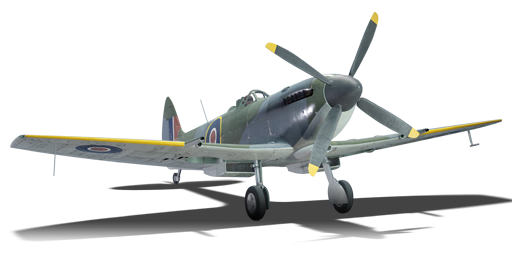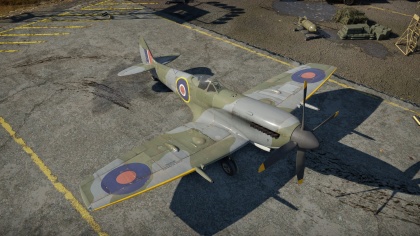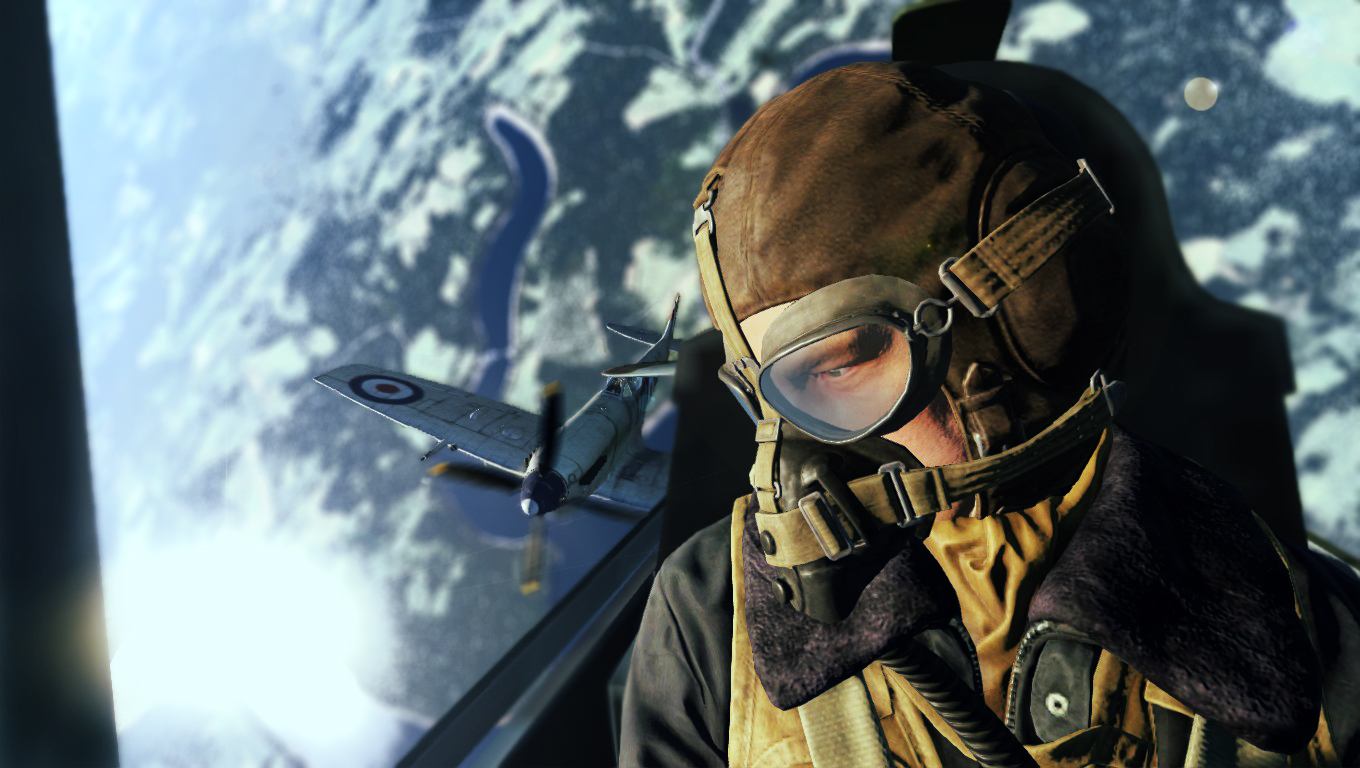Difference between revisions of "Spitfire F Mk XVI"
(Edits) |
(→Usage in battles) (Tag: Visual edit) |
||
| Line 132: | Line 132: | ||
== Usage in battles == | == Usage in battles == | ||
| − | <!-- ''Describe the tactics of playing in the aircraft, the features of using aircraft in a team and advice on tactics. Refrain from creating a "guide" - do not impose a single point of view, but instead, give the reader food for thought. Examine the most dangerous enemies and give recommendations on fighting them. If necessary, note the specifics of the game in different modes (AB, RB, SB).'' --> | + | [[File:Spitfire F Mk XVI tailing.jpg|frame|460x460px]]<!-- ''Describe the tactics of playing in the aircraft, the features of using aircraft in a team and advice on tactics. Refrain from creating a "guide" - do not impose a single point of view, but instead, give the reader food for thought. Examine the most dangerous enemies and give recommendations on fighting them. If necessary, note the specifics of the game in different modes (AB, RB, SB).'' --> |
The Spitfire F Mk XVI is quite unique with its clipped wings. These give this version of the Spitfire a distinct advantage in roll rate, dive performance, and level top speed. However, they reduce the plane's ability to turn, and unlike other Merlin Spitfires this one is only average in its turning ability. Thankfully, it retains a good rate of climb, even if it is not as high as that of the unclipped Spitfire variants. In addition, the clipped wings reduce lift at high altitudes, so performance is best when closer to sea level. | The Spitfire F Mk XVI is quite unique with its clipped wings. These give this version of the Spitfire a distinct advantage in roll rate, dive performance, and level top speed. However, they reduce the plane's ability to turn, and unlike other Merlin Spitfires this one is only average in its turning ability. Thankfully, it retains a good rate of climb, even if it is not as high as that of the unclipped Spitfire variants. In addition, the clipped wings reduce lift at high altitudes, so performance is best when closer to sea level. | ||
| Line 238: | Line 238: | ||
== See also == | == See also == | ||
''Links to the articles on the War Thunder Wiki that you think will be useful for the reader, for example:'' | ''Links to the articles on the War Thunder Wiki that you think will be useful for the reader, for example:'' | ||
| + | |||
* ''reference to the series of the aircraft;'' | * ''reference to the series of the aircraft;'' | ||
* ''links to approximate analogues of other nations and research trees.'' | * ''links to approximate analogues of other nations and research trees.'' | ||
| Line 243: | Line 244: | ||
== External links == | == External links == | ||
''Paste links to sources and external resources, such as:'' | ''Paste links to sources and external resources, such as:'' | ||
| + | |||
* ''topic on the official game forum;'' | * ''topic on the official game forum;'' | ||
* ''encyclopedia page on the aircraft;'' | * ''encyclopedia page on the aircraft;'' | ||
Revision as of 01:05, 22 December 2020
Contents
| This page is about the British fighter Spitfire F Mk XVI. For other versions, see Spitfire (Family). |
Description
The Spitfire F Mk XVI is a rank III British fighter
with a battle rating of 4.7 (AB) and 5.0 (RB/SB). It has been in the game since the start of the Open Beta Test prior to Update 1.27.
The Spitfire F Mk XVI is a very unique plane with an awkwardly unique role and design. Virtually identical to the Spitfire LF Mk IX, aside from the clipped wings and bubble cockpit, the Mk XVI combines the low-altitude capabilities of the aforementioned fighter with the fantastic roll, dive, and speed capabilities of the German Focke-Wulfe 190 series.
The Mk XVI possesses all the characteristics of the LF Mk IX regarding armament and performance at low-altitude. Low-altitude climb acceleration is fantastic, the climb rate is very good, and armament is extremely effective. The main distinguishing feature of the Mk XVI is its clipped wings. These wings give the Mk XVI some distinct advantages- a great roll rate and amazing dive and level speed and acceleration. The roll rate makes evasion a very easy task- rolling manoeuvres can easily evade most tail-end attacks by any fighter in the 4.0-6.0 BR range. Even more, the clipped wings of the XVI provide for very good low-altitude speed and acceleration performance- this fighter climbs like a rocket and dives like a hornet below 1,500 m.
However, the clipped wings can provide some significant disadvantages to flying, as well. Compared to similar Merlin Spitfires the turn rate is far worse, higher-altitude performance is abysmal, and climb performance is worse, though marginally.
Weaponry is standard, except for the 2 x Browning M2 12.7 mm HMGs that replace the standard 4 x Browning .303 machine guns. As a matter of fact, the two M2s provide a significant increase in firepower. When equipped with Universal or Stealth belts they provide excellent "soft" ground target dispatching performance while proving effective as a last-ditch weapon. As with most of the Spitfire line, the Mk XVI possesses 2 x Hispano-Suiza Mk.II 20 mm cannons which are highly effective against most fighters, especially when utilising the "Air Targets" belt.
Thus, the Spitfire F Mk XVI is not a suitable Boom & Zoom nor high-altitude fighter; it works best as a low-altitude fighter-bomber that can effectively take out ground targets while providing good fighter cover. Boom and Run is by far the best-recommended tactic.
General info
Flight performance
| Characteristics | Max Speed (km/h at 6,098 m) |
Max altitude (metres) |
Turn time (seconds) |
Rate of climb (metres/second) |
Take-off run (metres) | |||
|---|---|---|---|---|---|---|---|---|
| AB | RB | AB | RB | AB | RB | |||
| Stock | 624 | 605 | 11000 | 21.0 | 21.8 | 17.5 | 17.5 | 390 |
| Upgraded | 683 | 651 | 18.7 | 19.8 | 29.2 | 22.3 | ||
Details
| Features | ||||
|---|---|---|---|---|
| Combat flaps | Take-off flaps | Landing flaps | Air brakes | Arrestor gear |
| X | X | ✓ | X | X |
| Limits | ||||||
|---|---|---|---|---|---|---|
| Wings (km/h) | Gear (km/h) | Flaps (km/h) | Max Static G | |||
| Combat | Take-off | Landing | + | - | ||
| 774 | 260 | N/A | N/A | 260 | ~9 | ~5 |
| Optimal velocities (km/h) | |||
|---|---|---|---|
| Ailerons | Rudder | Elevators | Radiator |
| < 321 | < 400 | < 350 | > 500 |
| Compressor (RB/SB) | ||
|---|---|---|
| Setting 1 | ||
| Optimal altitude | 100% Engine power | WEP Engine power |
| 3,400 m | 1,380 hp | 1,766 hp |
| Setting 2 | ||
| Optimal altitude | 100% Engine power | WEP Engine power |
| 7,200 m | 1,190 hp | 1,523 hp |
Survivability and armour
- 38 mm Bulletproof glass - Armoured windscreen
- 4 mm Steel plate in pilot's seat
- 3-7 mm Steel plate behind the pilot
- 6 mm Steel plate in front of liquid cooling system
- 1 mm Steel plate in front of fuel tanks
- 3 mm Steel boxes around wing ammunition
Armaments
Offensive armament
The Spitfire F Mk XVI is armed with:
- 2 x 20 mm Hispano Mk.II cannons, wing-mounted (135 rpg = 270 total)
- 2 x 12.7 mm M2 Browning machine guns, wing-mounted (260 rpg = 520 total)
Suspended armament
The Spitfire F Mk XVI can be outfitted with the following ordnance:
- Without load
- 2 x 250 lb G.P. Mk.IV bombs (500 lb total)
Usage in battles
The Spitfire F Mk XVI is quite unique with its clipped wings. These give this version of the Spitfire a distinct advantage in roll rate, dive performance, and level top speed. However, they reduce the plane's ability to turn, and unlike other Merlin Spitfires this one is only average in its turning ability. Thankfully, it retains a good rate of climb, even if it is not as high as that of the unclipped Spitfire variants. In addition, the clipped wings reduce lift at high altitudes, so performance is best when closer to sea level.
Thanks to a great roll rate, this Spitfire is very capable in defensive manoeuvres, and although turn rate is decreased, the boost in roll speed make this a great dogfighter as well.
This vehicle maximizes its performance at low altitudes. Below 1500 m, it has an incredible rate of climb, very good top speed and acceleration, great dive performance, and generally outmatches its opponents. Still, there are some American and German planes that can outspeed and outdive this plane (especially since it locks up and may rip at high speeds), and the unclipped Merlin Spitfires outclimb this one.
This plane is equipped with 2 x 20 mm cannons and 2 x 12.7 mm machine guns. These are effective against fighters but may struggle against large planes such as heavy bombers. They can't destroy well-armoured ground targets, but can destroy lightly- or un-armoured ground targets and open top vehicles. Since all of these guns are wing-mounted, convergence should be kept in mind. A good convergence setting is usually between 300 and 500 m. Since cannon ammunition is somewhat limited, firing the 12.7 mm machine guns alone can be a good way to visualize the lead required to shoot enemies at longer ranges.
The Spitfire can also mount 2 x 250 lb bombs for destroying ground targets. These are quite small and must be aimed precisely to destroy the target. While this plane can be used in Ground Realistic battles, the fact that it can only carry 2 small bombs reduces its anti-ground capabilities. Instead, this plane can work as an air-superiority fighter in mixed battles.
The Spitfire F Mk XVI can rightly be considered a jack of all trades. It has some limited ground-attack capacity, decent guns, and flight characteristics that don't stand out in any one aspect. With a great roll rate; good dive and climb performance; and good energy retention, speed, and acceleration; this vehicle is a great low-altitude fighter as long as its weaknesses are understood.
Manual Engine Control
| MEC elements | ||||||
|---|---|---|---|---|---|---|
| Mixer | Pitch | Radiator | Supercharger | Turbocharger | ||
| Oil | Water | Type | ||||
| Controllable | Controllable Auto control available |
Not controllable Not auto controlled |
Controllable Auto control available |
Combined | Controllable 2 gears |
Not controllable |
Modules
| Tier | Flight performance | Survivability | Weaponry | ||
|---|---|---|---|---|---|
| I | Fuselage repair | Radiator | Offensive 12 mm | Offensive 20 mm | |
| II | Compressor | Airframe | New 12 mm MGs | New 20 mm cannons | |
| III | Wings repair | Engine | SBC mark 25 | Mk.II year 1942 | |
| IV | Engine injection | Cover | Mk.II year 1943 | ||
Pros and cons
Pros:
- Good climb speed, albeit lower than non-clipped wing variants
- New M2 HMGs are far more effective than the Browning .303s
- Great roll rate
- Good guns
- Great dive acceleration
- Better dive speed than other Merlin Spitfires
- Better turning that most of its German and American counterparts
- Ability to mount bombs for a decent late-game ground attack option
- Slightly better simulator visibility due to its bubble cockpit
- Stock parts are not as bad as some other T4-5 planes, such as the P-51D-5, Ki-84 and Late Bf109s
Cons:
- Worse turning than all other Merlin Spitfires
- Worse dive speed than its German and American counterparts
- Poor performance at altitude
- Relatively low rip speed (650 kph)
- The RAF M2 HMGs are not as good as their American counterpart, the M2 Early/Late
History
In-game description
The Supermarine Spitfire was a British single-engine, all-metal, low-wing monoplane fighter. Various modifications served as fighters, interceptors, high-altitude fighters, fighter-bombers and reconnaissance aircraft.
The Mk XVI variant was very similar to the Mk IX; however, it was powered by a US-manufactured Packard Merlin 266 engine. A total of 1,054 Spitfires of this variant were produced. All production variants had the distinguishing feature of low-altitude clipped wings and a cut down rear fuselage and bubble canopy for increased visibility. The clipped wings increased the roll rate and top speed due to a reduction in drag, but sacrificed some of the fighter's rate of climb. This, coupled with an engine optimised for efficiency in denser air made the Mk XVI ideally suited to combat at lower altitudes.
Media
See also
Links to the articles on the War Thunder Wiki that you think will be useful for the reader, for example:
- reference to the series of the aircraft;
- links to approximate analogues of other nations and research trees.
External links
Paste links to sources and external resources, such as:
- topic on the official game forum;
- encyclopedia page on the aircraft;
- other literature.
| Supermarine | |
|---|---|
| Spitfires | |
| Merlin engine | Spitfire Mk Ia · Spitfire Mk IIa · Spitfire Mk.IIa Venture I · Spitfire Mk IIb |
| Spitfire Mk Vb · Spitfire Mk Vb/trop · Spitfire Mk Vc · Spitfire Mk Vc/trop | |
| Spitfire F Mk IX · Spitfire F Mk IXc · Spitfire F Mk XVI | |
| Spitfire LF Mk IX · Plagis' Spitfire LF Mk IXc | |
| Griffon engine | Spitfire F Mk XIVc · Spitfire F Mk XIVe · Prendergast's Spitfire FR Mk XIVe · Spitfire F Mk XVIIIe · Spitfire F Mk 22 · Spitfire F Mk 24 |
| Export | ▄Spitfire Mk Vb/trop · ▃Spitfire LF Mk IXc · ▂Spitfire Mk IXc · Spitfire Mk IXc · Spitfire Mk.IX (CW) · Weizman's Spitfire LF Mk.IXe · ▄Spitfire FR Mk XIVe |
| Seafires | Seafire LF Mk.III · Seafire F Mk XVII · Seafire FR 47 |
| Export | ▄Seafire LF Mk.III |
| Jet fighters | Attacker FB 1 · Attacker FB.2 · Scimitar F Mk.1 · Swift F.1 · Swift F.7 |
| Hydroplanes | Walrus Mk.I |






